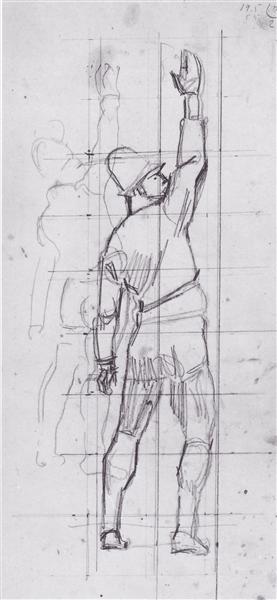Description
Ferdinand Hodler, a enduring name in the field of symbolism and Swiss expressionism, is distinguished by being one of the most important artists in Europe at the beginning of the 20th century. The painting "curse from behind" ("Swearing from Behind") of 1912 is one of his less known works but no less shocking. This piece encapsulates the technical mastery and emotional depth that characterize Hodler, showing a style and execution that invite both contemplation and reflection.
By observing "curse from behind", which immediately captures attention is your careful composition and intensity of the colors used. The male figure, with its back to the viewer, presents a tension posture contained, hinted at the stiffness of their shoulders, the turn of its head and the gesture of the raised arm. Hodler's choice to show the subject on his back is remarkably effective; An air of mystery is created and causes an introspection situation where the viewer is forced to imagine the face and emotions of man.
The chromatic range used is sober but shocking, with mostly dark tones that contribute to the severe atmosphere of the scene. Contrasting with the clearest background, the protagonist's figure stands out strongly, almost emerging from the canvas. The chiaroscuro technique, managed in a subtle and effective way, reinforces the character's three -dimensionality and emphasizes the expressiveness of the captured gesture. Hodler handles light with precision and delicacy, creating shadows that, although subtle, enrich the feeling of volume and depth.
A crucial aspect of Hodler's work is his ability to express deep human emotions through his works. In "curse from behind", the feeling of frustration, anger or despair is palpable, although never explicitly detailed. This ambiguity encourages a personal interpretation, transforming the work into a mirror of the emotional state of whoever observes it.
Historically, Ferdinand Hodler has been recognized for his interest in human nature and his studies on the psychology of movement and body expression. This approach is clearly visible in "curseing from behind", where each stroke and every shading seem deliberately calculated to communicate a specific range of feelings. This interest in movement and expression can also be observed in other works by Hodler such as "The Night" ("The Night", 1890) and "The Eurythmie" (1895), where the artist addresses sleep, death and rhythm themes Body with an almost scientific look.
Little is known about the exact circumstances that surrounded the creation of "curse from behind." However, understanding Hodler's trajectory and his historical context, it is plausible that the work is a reflection of the personal and social tensions of the time. The Swiss democratic reform and the emotional conflicts of Hodler himself probably influenced this painting, as in many of his other creations.
In conclusion, "curseing from behind" is a work that, although it is not one of Hodler's most widespread, represents a faithful testimony of his ability to capture human essence through art. Each element of the painting, from its composition to its color, is imbued with a deeply emotional and artistic intention, making this work a paradigmatic example of talent and vision of Ferdinand Hodler.
KUADROS ©, a famous paint on your wall.
Hand-made oil painting reproductions, with the quality of professional artists and the distinctive seal of KUADROS ©.
Art reproduction service with satisfaction guarantee. If you are not completely satisfied with the replica of your painting, we refund your money 100%.

